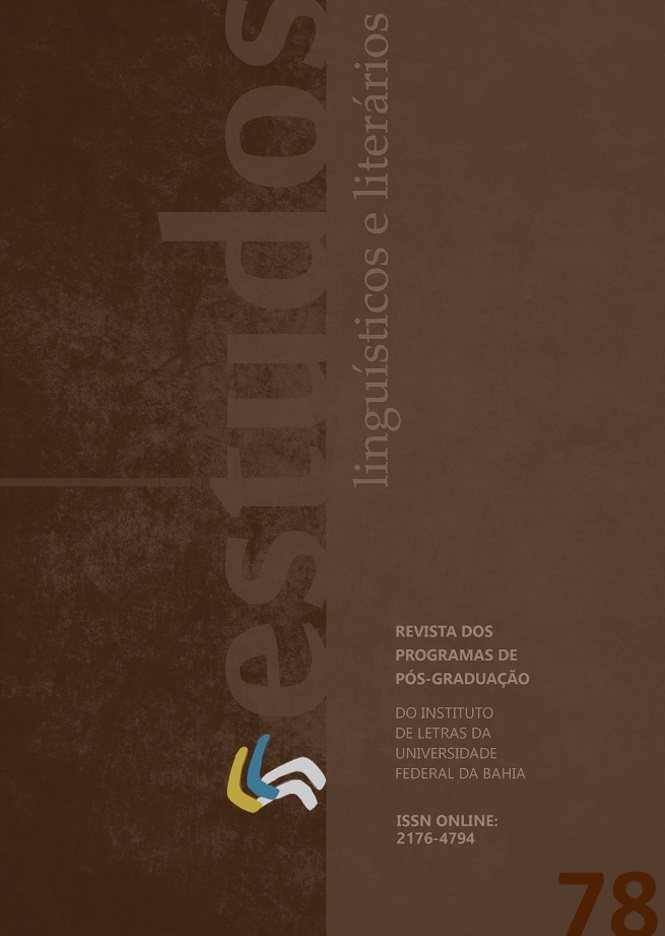DISTRIBUTION OF RHOTIC SOUNDS IN PORTUGUESE VARIETIES IN AFRICAN COUNTRIES
DOI:
https://doi.org/10.9771/ell.v0i78.55618Abstract
This study aimed at establishing and comparing the distribution of rhotics of five Portuguese African varieties (Angola, Cape Verde, Guinea-Bissau, Mozambique and São Tomé and Príncipe), while also determining similarities and differences with regard to the Brazilian and European varieties, based on the acoustic analysis of 18 sociolinguistic interviews. It was found that the system of rhotics in the analyzed varieties is similar to that of European Portuguese. However, divergent patterns were found, such as the occurrence of (1) tap in all phonological contexts, including at the beginning of a word; (2) fricatives in coda position in Cape Verde; (3) variation between trills, velar and uvular fricatives at the beginning of words in Angola; (4) epenthetic vowel in consonant clusters and in coda; (5) deletion of final rhotics in São Tomé and Príncipe. A multiplicity of variantes and the pervasive occurrence of the tap may be an indicator of change to a single rhotic system.
Downloads
References
ASSIS, Maria Cristina de. História da língua portuguesa. São Paulo: Contexto, 2011.
CANTONI, Maria; MADRUGA, Magnun. R. Phonology. In: OUSHIRO, L.; CARVALHO, A. M. (org.). The Oxford Handbook of the Portuguese Linguistics. Oxford University Press. (no prelo)
CARVALHO, Ana Maria; LUCCHESI, Dante. Portuguese in contact. In: WETZELS, W. Leo; MENUZZI, Sérgio; COSTA, João (orgs.). The handbook of Portuguese linguistics. Wiley-Blackwell, 2016. p. 41-55.
CRISTÓFARO SILVA, Thaïs et al. Fonética Acústica: os sons do português brasileiro. Editora Contexto, 2019.
CHRISTOFOLETTI, Alfredo; ARAÚJO, Gabriel. Vogais e ditongos no português vernacular de São Tomé e Príncipe. In: OLIVEIRA, Márcia S. D.; ARAÚJO, Gabriel A. de (orgs.). O Português na África Atlântica. São Paulo: FFLCH/USP, 2018. p. 258-296.
GONÇALVES, Perpétua. Contacto de línguas em Moçambique: algumas reflexões sobre o papel das línguas bantu na formação de um novo léxico do português. In: LOBO, T., CARNEIRO, Z., SOLEDADE, J., ALMEIDA, A.; RIBEIRO, S. (orgs.). Rosae: linguística histórica, história das línguas e outras histórias. Salvador: EDUFBA, 2012, p. 401-406.
GONÇALVES, Perpétua. Falsos sucessos no processamento do input na aquisição de L2: papel da ambiguidade na gênese do português de Moçambique. Revista da ABRALIN, v. 4, n. 1/2, p. 47-73, 2005.
HAGEMEIJER, Tjerk. As línguas de S. Tomé e Príncipe. Revista de crioulos de base lexical portuguesa e espanhola, v. 1, p. 1-27, 2009.
HASPELMATH, Martin; APiCS Consortium. The segment [h]. In: MICHAELIS,, Susanne ; MAURER, Philippe; HASPELMATH, Martin; HUBER, Magnus (orgs.). The atlas of pidgin and creole language structures. Oxford University Press, 2013.
INVERNO, Liliana. Angola’s transition to Vernacular Portuguese. 2005. Dissertação. (Mestrado) Universidade de Coimbra.
JESUS, Luis M. T.; SHADDLE, Christine H. Acoustic Analysis of European Portuguese uvular and voiceless tapped alveolar fricatives. Journal of the International Phonetic Association, v. 35, n. 1, p. 27-44, 2005.
JON-AND, Anna. Variação, contato e mudança linguística em Moçambique e Cabo Verde: a concordância variável de número em sintagmas nominais do português. 2011. Tese. (Doutorado) Department of Spanish, Portuguese and Latin American Studies, Stockholm University.
LADEFOGED, Peter. A course in phonetics. 5a ed. Boston: Thomson Wadsworth, 2006.
LOPES, Francisco João; OLIVEIRA, Marcia Santos Duarte. Estudos sobre o português falado em Cabo Verde: o ‘estado da arte’. In: OLIVEIRA, Márcia S. D.; ARAÚJO, Gabriel A. de (orgs.). O português na África Atlântica. São Paulo: FFLCH/USP, 2018. p. 101-138.
MASSINI‐CAGLIARI, Gladis; CAGLIARI, Luiz Carlos; REDENBARGER, Wayne J. A comparative study of the sounds of European and Brazilian Portuguese: Phonemes and allophones. In: WETZELS, W. Leo; MENUZZI, Sérgio; COSTA, João (orgs.). The handbook of Portuguese linguistics. Wiley-Blackwell, 2016. p. 56-68.
MATEUS, Maria Helena; D'ANDRADE, Ernesto. The phonology of Portuguese. Oxford: Cambridge University Press, 2000.
MONARETTO, Valéria. Um reestudo da vibrante: análise variacionista e fonológica. Porto Alegre, 1997.
PEREIRA, Rodrigo; HAGEMEIJER, Tjerk; FREITAS, Maria João. Consoantes róticas e variação no português de São Tomé. Revista da Associação Portuguesa de Linguística, n. 4, p. 206-224, 2018.
RStudio Team. RStudio: Integrated Development for R. RStudio, PBC, Boston, MA. 2020. Disponível em http://www.rstudio.com/.
RENNICKE, Iiris. The retroflex r of Brazilian Portuguese: theories of origin and a case study of language attitudes in Minas Gerais. Linguística, v. 6, 2011.
RENNICKE, Iiris. Variation and change in the rhotics of Brazilian Portuguese. 2015.
SANTOS, Vinícius Gonçalves dos; SVARTMAN, Flaviane Romani Fernandes. Contribuições para o estudo da prosódia do português de Guiné Bissau: a entoação do contorno neutro. In: OLIVEIRA, Márcia S. D.; ARAÚJO, Gabriel A. de (orgs.). O Português na África Atlântica. São Paulo: FFLCH/USP, 2018.
SANTOS, Eduardo Ferreira dos; SILVA, Raquel. Estudo inicial das perguntas-Q no português de Guiné-Bissau. In: OLIVEIRA, Márcia S. D.; ARAÚJO, Gabriel A. de (orgs.). O Português na África Atlântica. São Paulo: FFLCH/USP, 2018. p. 237-260.
TEYSSIER, Paul. História da língua portuguesa. Trad. de Celso Cunha. 4. ed. São Paulo: Martins Fontes, 2014.
VEIGA, Manuel. Cabo Verde: da Diglossia à Construção do Bilinguismo. PAPIA: Revista Brasileira de Estudos do Contato Linguístico, v. 25, n. 2, p. 177-187, 2015.


